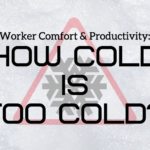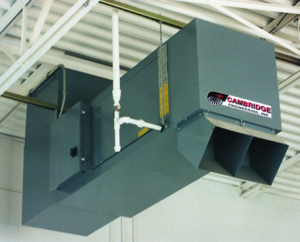I have written several articles about the importance and benefits of comfort cooling in facilities where workers are exposed to hot temperatures. A recent cold snap here in Texas made me think about the concept of comfort heating for workers exposed to cold temperatures. After a little research, I have found the importance and benefits are surprisingly similar.
How Cold Affects a Person
 We all know that extremely cold temperatures can lead to hypothermia and frostbite. However, long before those conditions set in, the human body begins a defense to conserve body heat. The body first begins by restricting blood flow to the extremities to preserve the heat in the body core and vital organs. This is why our hands and feet are where we first notice the effects of cold temperatures.
We all know that extremely cold temperatures can lead to hypothermia and frostbite. However, long before those conditions set in, the human body begins a defense to conserve body heat. The body first begins by restricting blood flow to the extremities to preserve the heat in the body core and vital organs. This is why our hands and feet are where we first notice the effects of cold temperatures.
The next defense is rapid rhythmic muscle contractions or simply shivering. This is the body’s way of generating heat to stay warm. Shivering can become intense and uncomfortable if the body perceives a threat and the necessity to generate more heat as a defense to the cold environment.
Finally, the body will begin to consume glucose from the blood stream to keep itself warm. Glucose is the brain’s main energy source therefore, the longer a body is in defense mode against the cold, depleted levels of glucose can begin to impact brain function. Persons with low glucose levels have been associated with having reduced cognitive abilities such as concentration, inspiration and insight.
What is Less Than Ideal Temperature
There is not a clear consensus from the authoritative literature I read as to where an industrial worker’s productivity begins to decline due to cold temperatures. Studies involving office workers performing manual dexterity tasks have identified 68ºF as the point where productivity begins to decline. In support of that conclusion, OSHA has set 68ºF as the low point in its range of recommended temperatures for worker comfort.
A well-known study by Thomas and Yiakoumis (1987) of workers performing a variety of construction related tasks found that 50ºF was the point where productivity began to decline. Their data shows the productivity decline was over 1% for every degree under 50ºF. Another study by Grimm and Wagner (1974) on construction workers found that productivity began to decline at 75ºF and that the rate of decline was over 1% for every degree below that point.
The conclusion that I make from all of this, is any industrial facility where a worker can be exposed to cold temperatures should be heated to a minimum of 50ºF. This is provided that workers can wear additional clothing for thermal comfort. Where manual dexterity is required or bulky clothing is a safety risk, such as in a machine shop, the minimum temperature to be maintain should be closer to 68ºF.
Conclusion
I found compelling evidence that comfort heating is just as important as comfort cooling to maintain worker safety and productivity. Worker productivity gain achieved by maintaining a comfortable temperature of at least 50ºF would provide a payback of investment in comfort heating equipment. In Texas and Louisiana, Eldridge has partnered with Cambridge Air Solutions to provide comfort heating solutions to industrial customers. Let us help you find the comfort heating solution that will keep your workers safe, comfortable and productive this winter.
